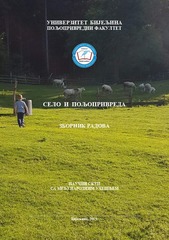Приказ основних података о документу
Prinos zrna kukuruza u zavisnosti od tipa zemljišta, količine azota i hibrida
Grain yield of corn depending on the soil type, quantity of nitrogen and hybrids
| dc.creator | Živanović, Ljubiša | |
| dc.creator | Golijan, Jelena | |
| dc.creator | Šarčević-Todosijević, Ljubica | |
| dc.creator | Ikanović, Jela | |
| dc.creator | Kolarić, Ljubiša | |
| dc.creator | Popović, Vera | |
| dc.date.accessioned | 2021-11-25T11:36:57Z | |
| dc.date.available | 2021-11-25T11:36:57Z | |
| dc.date.issued | 2019 | |
| dc.identifier.isbn | 978-99976-751-2-5 | |
| dc.identifier.uri | http://fiver.ifvcns.rs/handle/123456789/2464 | |
| dc.description.abstract | U Srbiji, povećanje prinosa kukuruza po jedinici površine iziskuje povećanje genetičkog potencijala rodnosti novih hibrida, kao i poboljšanje tehnologije gajenja. Savremeni hibridi, pored većeg genetičkog potencijala rodnosti, treba da se karakterišu i većom tolerantnošću prema stresnim uslovima proizvodnje. Osnovni cilj ovog istraživanja bio je da se odredi optimalna količina azota za hibride različite dužine vegetacionog perioda na zemljištu tipa černozem i gajnjača i izvrši izbor ZP hibrida najbolje rodnosti za agroekološke uslove istočnog Srema i centralne Šumadije. Ispitivanja su obavljena putem poljskih mikroogleda u agroekološkim uslovima istočnog Srema (Zemun Polje) i centralne Šumadije (Rača Kragujevačka) metodom razdeljenih parcela u četiri ponavljanja. Rezultati ukazuju da je najjači uticaj na prinos zrna kukuruza imao tip zemljišta (veći prinos je zabeležn na gajnjači za 1.97 tha-1), zatim đubrenje azotom (povećanje prinosa od 0,92 do 1,25 tha-1) i najslabiji hibrid (najveći prinos zrna od 10,03 tha-1 zabeležen je u hibrida ZP 677). | sr |
| dc.description.abstract | In Serbia, increase in corn yield per unit area requires an increase in the genetic potential of the yield of new hybrids, as well as improved cultivation technology. Modern hybrids, in addition to the greater genetic potential of fertility, should also be characterized by higher tolerance to stressful production conditions. The aim of this research was to determine the optimal amount of nitrogen for hybrids of different lengths of the vegetation period on the soil of chernozem and brown forest soil and made the selection of ZP hybrids of the best fertility for the agroecological conditions of eastern Srem and central Šumadija. The experiments were carried out through field microscopes in the agroecological conditions of eastern Srem (Zemun Polje) and central Šumadija (Raĉa Kragujevaĉka) using the split plot plane in four repetitions. The results show that the strongest impact on maize grain yield was of the type of soil (the higher yield was recorded on the brown forest soil for 1.97 tha-1), then the nitrogen fertilization (increase in yield from 0.92 to 1.25 tha-1) and the weakest hybrid (the largest grain yield of 10.03 tha-1 is recorded in hybrid ZP 677). | sr |
| dc.language.iso | sr | sr |
| dc.publisher | Bijeljina : Univerzitet Bijeljina, Poljoprivredni fakultet | sr |
| dc.rights | openAccess | sr |
| dc.rights.uri | https://creativecommons.org/licenses/by/4.0/ | |
| dc.source | Zbornik radova, Selo i poljoprivreda, Bijeljina, 2019. | sr |
| dc.subject | kukuruz | sr |
| dc.subject | prinos | sr |
| dc.subject | zemljište | sr |
| dc.subject | hibridi | sr |
| dc.subject | đubrenje | sr |
| dc.subject | corn | sr |
| dc.subject | maize | sr |
| dc.subject | yields | sr |
| dc.subject | soil | sr |
| dc.subject | hybrids | sr |
| dc.subject | fertilization | sr |
| dc.title | Prinos zrna kukuruza u zavisnosti od tipa zemljišta, količine azota i hibrida | sr |
| dc.title | Grain yield of corn depending on the soil type, quantity of nitrogen and hybrids | sr |
| dc.type | conferenceObject | sr |
| dc.rights.license | BY | sr |
| dc.citation.epage | 123 | |
| dc.citation.spage | 112 | |
| dc.identifier.fulltext | http://fiver.ifvcns.rs/bitstream/id/6719/bitstream_6719.pdf | |
| dc.identifier.rcub | https://hdl.handle.net/21.15107/rcub_fiver_2464 | |
| dc.type.version | publishedVersion | sr |


